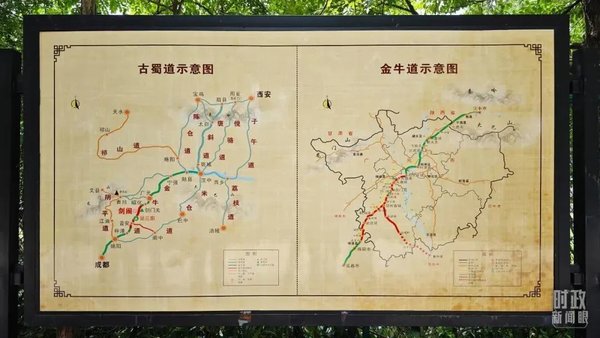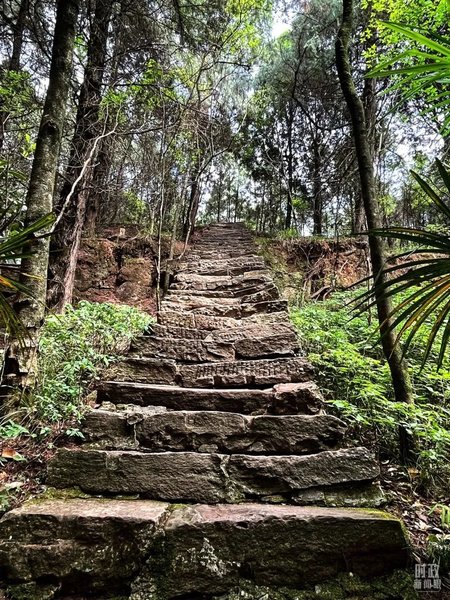Why is the ancient Shu Road, which is difficult to ascend to the blue sky, so important? Development | Qing Dynasty | Shu Road
What role does the Shu Road play in connecting the Central Plains and the Southwest region, promoting exchanges and integration among various ethnic groups, and maintaining national unity? What is the historical value of the rich natural and cultural heritage along the Sichuan Road? Recently, Dao Zhonghua interviewed Professor Ma Qiang from the School of History and Culture at Southwest University.
Dao Zhonghua: What is the Shu Road? What roads are included in this transportation network?
The following videos are sourced from
Planet Science Popularization Bureau
Ma Qiang: In the traditional sense, the Shu Road refers to the ancient transportation network that crossed the Qinling Mountains and Daba Mountains from Chang'an during the Zhou, Qin, Han, and Tang dynasties, passing through the Hanzhong Basin and leading to the Chengdu Plain.
Among them, the Qinling section mainly includes the Old Road, Baoxie Road, Tangluo Road, Ziwu Road, and Yinping Road. The Yin Ping Road crossed over the Motian Ridge from Wen County in Longnan and entered Shu. It was famous in history for the Wei general Deng Aijing's surprise attack on Shu Han during the Three Kingdoms period.
The ancient roads passing through Daba Mountain in the Hanzhong Basin are mainly Jinniu Road, Micang Road, and Lizhi Road. The lychee road is related to the transportation post road built by Yang Guifei, who enjoys eating fresh lychees. The Shu Road is therefore known as the "North Five South Three". Many sections of the Shu Road meander through the valleys and dangerous gorges of the Qinba Mountains, requiring logging and stacking for walking. Therefore, in the works of poets, the Shu Road is also known as the "plank road".

In addition, the Xiajiang Ancient Road, the Sichuan Yunnan Ancient Road, the Sichuan Guizhou Ancient Road, and the Sichuan Tibet Ancient Road all belong to the broad category of Sichuan roads.
▲ Schematic diagram of the ancient Shu Road.
Dao Zhonghua: When it comes to the Shu Road, people will associate it with Li Bai's "The difficulty of the Shu Road is greater than reaching the blue sky!" How was the Shu Road excavated and created?
Ma Qiang: The earliest ancient path that passed through the Shu Road, which Wang Guowei believed to be the "Zhou Road" in the bronze inscription "San Shi Pan", had already passed through during the Shang and Zhou dynasties. The vast majority of its land was formed on the basis of natural trampling by ancestors along the Jialing River valley. The old road is winding and remote, but it can basically walk along the valley.
The Baoxie Road, Tangluo Road, Ziwu Road, and Jinniu Road of the Shu Road pass through many sections of the dangerous river canyon. The ancestors invented the "plank road", which means digging stack holes on the stone walls of the Linjiang River, inserting wood as beams, standing water as columns, and setting up bridges and pavilions for passage. This is a major form of boardwalk.
However, during the Qin, Han, and Three Kingdoms periods, boardwalks were built near water, and once flash floods broke out, they were easily destroyed by floods. Starting from the Yuan Dynasty, some sections of the road were changed from "plank roads" with inserted columns and bridges to "winding roads" mainly made of soil and rock, that is, excavating soil and rock on the mountain to form roads and winding up the mountain. The "Bandao" spirals upwards, some reaching the mountaintop, and its steepness is even greater than that of the boardwalk.
In the early Eastern Han Dynasty, the imperial court issued an edict to expand the Baoxie Road. Ancestors excavated the first artificial mountain tunnel in Chinese history, the "Shimen", at the southern exit of the Baoxie Road. According to historical records, it was excavated using the method of "burning water with fire", which involves burning the rocks red with firewood, then pouring cold water on them to cause the rocks to explode, and then drilling holes in the mountains.
▲ Ancient Shu Road.

Dao Zhonghua: In ancient China, what role did the Shu Road play in connecting the Central Plains and the Southwest region?
Ma Qiang: Bashu and its connected regions of Guizhou, Yunnan and Xizang play an important role in the formation of the Chinese national community. The Shu Road served as a transportation artery connecting the political center of the country and the southwestern region in ancient China.
China is one of the earliest countries in the world to establish a relay station system, and throughout history, great importance has been placed on the construction and management of Sichuan Road relay stations. During the Ming and Qing dynasties, there was a post station located 30 to 40 miles away and a shop located 10 to 20 miles away. Until now, there are still many old place names with "post stations" and "shops" preserved in Jiange County, Guangyuan City, Sichuan Province. The Shu Road has important political, military, and economic significance for the governance of the Southwest region by the Central Plains dynasties, especially in maintaining national unity.
For example, the Shu Road was an important transportation route from the mainland to Sichuan and Tibet. In the Qing Dynasty, central envoys often took the route along the Shu Road when entering Tibet. In the twelfth year of the Yongzheng reign, Prince Aisin Gioro Yunli escorted the Dalai Lama back to Tibet and took the Shaanxi Sichuan Sichuan Road to cross Sichuan and enter Tibet; During the reign of Emperor Qianlong in the Qing Dynasty, when the rebellion in Jinchuan was suppressed, the Qing court issued multiple edicts to maintain smooth traffic on the Sichuan Shaanxi Sichuan Road, in order to ensure the transportation of grain, grass, and military supplies.
The Sichuan Road is still an important link connecting the Northwest Silk Road and the Southwest Silk Road. The Shu Road runs northwest from Baoji, Shaanxi, and can pass through Longshan, Tianshui, and Lanzhou in Gansu, connecting the Northwest Silk Road; To the southwest, you can follow the Lianyun Plank Road through Hanzhong and Guangyuan in Shaanxi to enter Yunnan, connecting with the Southwest Silk Road.
Dao Zhonghua: What is the value of the rich natural and cultural heritage along the Sichuan Road today?
Ma Qiang: The Shu Road has a long history and rich cultural heritage. It is a rich area of historical and cultural heritage, including ancient mountain road engineering technology, ancient travel literature, ancient calligraphy history, ancient military heritage, ancient immigration channels, and other cultural heritage.
Among them, Shu Road literature is a beautiful scenery. In the Yuefu poems of the Wei, Jin, and Southern Dynasties, there is a poetic title called "Difficulty of the Shu Road", which mainly describes the hardships and sorrows of tourists along the Shu Road. The Song Dynasty poet Guo Maoqian's "Yuefu Poetry Collection" includes two poems by Emperor Jianwen of the Southern Liang Dynasty titled "Difficulties on the Shu Road". During the Tang and Song dynasties, Shu Road literature flourished, and during this period, most famous poets had traveled to Shu Road and left behind their poems and writings. Li Bai's "Difficulty in the Shu Road", Du Fu's "Journey to Longshu", Bai Juyi's "Ba Di", Yuan Zhen's "Ba Shu Zai", Xue Neng, Sun Qiao, Wei Zhuang and others' "Shu Zhong" poems, as well as Su Shi's father and son, Fan Zuyu, Huang Tingjian, Lu You, Fan Chengda and others from the Song Dynasty, have also left some Shu Road poems.

In addition, Shu Road stone carvings also hold an important position in the history of Chinese calligraphy. The Han Dynasty stone carving calligraphy is very rare, and the famous Han Li "Han San Song", namely the "Xixia Song" at the foot of Tianjing Mountain in Chengxian County, Gansu, the "Fuge Song" at Lingya Temple in Lueyang, Shaanxi, and the "Shimen Song" at Baogukou in Hanzhong, Shaanxi, have been well preserved to this day.
At the southern end of the Baogu Pass in Hanzhong, there is also the classic Northern Wei calligraphy "Inscription on the Stone Gate" and a large number of stone inscriptions left by literati in the Song, Ming, and Qing dynasties. This is a precious stone specimen in the history of Chinese calligraphy, which clearly reflects the evolution process and trajectory from Han Li to Wei Bei, and then to Song Dynasty Kai and Xingshu.
In terms of ecology, the Jianmen Mountain area of Sichuan Province is suitable for the growth of cypress trees. For thousands of years, the local tradition of planting cypress trees has formed the largest Berlin district in northern Sichuan. There are currently 7778 ancient cypress trees in Jiange County, with an average age of 1050 years. Among them, the oldest tree is about 2300 years old and is known as the "Wonder of the Sichuan Road" and "Forest Living Fossil", which has important research and protection value.
Nowadays, Sichuan Road is still a cultural and tourism area with great development potential. The ancient historical and legendary relics of Shu, cultural relics of the Three Kingdoms, and famous military passes in ancient times, such as Jianmen Pass, Baishui Pass, Tianxiong Pass, Yangping Pass, Dashan Pass, and Wuxiu Pass, are all important resources for the protection and cultural tourism development of modern Shu Road.
The above content is the personal opinion of experts and does not represent the position of this platform
Interviewee profile:
Ma Qiang, a professor at the School of History and Culture of Southwest University, and the chief expert of the National Social Science Foundation's major project "Sichuan Road Literature Sorting and Research".
Responsibility





